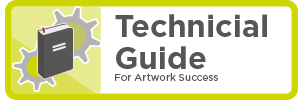Artwork Guidelines
Welcome to the Artwork Guide and thank you for choosing us, we’ll make this as simple as possible for you to ensure a smooth journey for you and your business. From design to finalised printed product.
We are there to assist you every step of the way, and our own in-house studio is always at hand to help or simply complete the artwork process for you.
Here you can find the information you may need before sending in your files for print, remember any questions you may have that haven’t been answered for you here can be answered by our sales team at 01767 603930 or Contact Us.
Paper Size
Please set up the page size of your document at the exact size that you wish your job to print. Do not supply artwork floating on a larger page or include multiple pages on the same page.
Fonts
When supplying a PDF file, all the fonts should be embedded and only correctly licensed fonts should be used. If supplying original artwork all the font files must be included within a clearly marked folder within the main artwork folder.
Bleed & Crop Marks
Bleed: If your design includes colour or images which are printed up to the edge of the page, please provide additional artwork to all sides. This is called ‘bleed’. Bleed avoids the risk of white edges on your work.
- Commercial Print Bleed add 3mm to all sides
- Display & Exhibition Print Bleed add 6mm to all sides
- Textile Display & Exhibition Print Bleed add 25mm to all sides.
Crop Marks: Show us the edge of your work so we know exactly where to trim it.
Photos, Scans & Images
All scans and images included in your artwork file should be supplied at least 300dpi for commercial print or 120dpi for display/exhibition print, and in the correct colour mode at the final print size.
Images and logos saved from websites are mostly between 72-96dpi and are therefore seldom suitable for printing. If you upscale or add resolutions to images in your image editing software, this will not increase the quality of the image and may result in blurry or bit-mapped images. For example, a 300dpi image scaled up by 400% when placed is only 75dpi!
We recommend using professional images to enhance your design. There are many companies supplying stock images online, for example, AdobeStock, Shutterstock or Getty Images.
Colours
Process Colours are referred to as CMYK, Cyan (C), Magenta (M), Yellow (Y) and Black (K), four colour process or even just process. These different colours are used to reproduce a colour image. Combined together in varying proportions CMYK produces the full-colour spectrum.
Pantone colours are often specified for printing as a ‘spot colour’, a specific colour printed using an ink made exclusively and typically for jobs which require no full-colour imagery like colour matching for corporate branding to ensure consistent colour reproduction.
- Pantone spot colours that are intended to be four colour process and litho printed should be converted to CMYK using the Pantone+ Color Bridge® library. This is not necessary for digital printing as our digital presses create a colour simulation for spot colours.
- Convert all RGB colours to CMYK as colour separations for printing cannot be made from RGB files.
- If your job is full colour, please ensure that you work entirely in CMYK. If your program does not support CMYK or Pantone, we will need to convert your colours before printing.
- Please bear in mind that monitors and desktop printers do not produce accurate representations of the press printed colour.
File Formats
We operate a PDF print production workflow, so high quality PDF’s are the best format for you to provide your print-ready artwork, please make sure your images at ‘print size’ are at least 300dpi for ‘Commercial Print’ and 120dpi for ‘Wide format or Exhibition print’ and please make sure all colours etc. are correct. (If you are unsure, our friendly sales team can arrange for the studio to do an artwork suitability check for you, wherever possible please also attached the ‘original artwork creation’ files.)
We accept artwork created in any of the following software packages:
- Adobe InDesign
- Adobe Illustrator
- Adobe Photoshop
- QuarkXpress
- Please be aware that files from the Microsoft Office suite of programs (Word, PowerPoint, Excel and Publisher) are not designed for commercial printing. However, our studio service can assist in creating print-ready files.
Transferring Artwork for Print
InDesign and QuarkXpress allow the packaging of artwork which collects the artwork and all images and fonts in a convenient folder. InDesign does this via the Package command and Quark via the Collect for Output command.
All placed images and used fonts must be included along with the artwork file. It is a good working practice to include (at least) a low-resolution PDF along with any original artwork to check against.
If supplying original artwork, all placed images and elements (AI, PS, TIFF, EPS, JPEG, PNG etc) must be included within a clearly marked folder, eg. Images or Links within the main artwork folder.
Creating a Print-ready PDF
To prepare your files for print, for the best results we prefer to receive artwork as a press-ready PDF.
- All PDFs should be set to high resolution to be press-ready
- All PDFs must include bleed and crop marks
- All fonts must be embedded within Adobe Acrobat: the ‘File > Properties > Fonts’ tab shows a full list of fonts used in the document. Every font should show as embedded or an embedded subset
- Any process colours are converted to CMYK prior to creating a PDF. Converting spot colours to CMYK after creating a PDF may produce unexpected results (especially when transparent effects are involved)
- We recommend using the PDF/X-3 standard
- We recommend checking a PDF using the Output Preview prior to sending us your file. This can show overprinting and will list all the separations included
Sending your Print Files to Parkes
We can accept all files electronically.
Small Files Files up to 6mb can be emailed to our sales team at web@parkesexpo.com.
Larger files up to 5GB in size, please use or easy online Dropbox file upload to ‘Upload Your Artwork’.
Alternatively, you can send us your file(s) on a memory stick, CD or use an online file transfer platform such as WeTransfer, Dropbox or MailBigFile (The transfer completion time depends on the speed of your internet connection and the file size).






